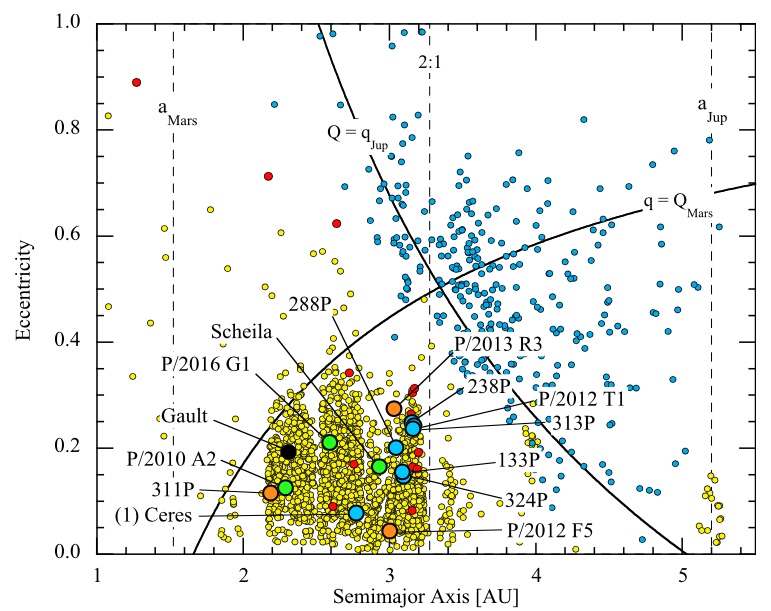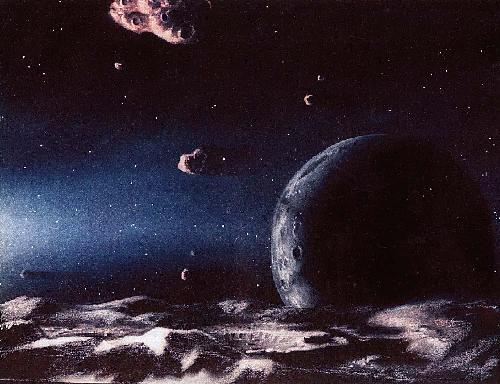
| The Active Asteroids |
|---|
Introduction
Active Asteroids are a newly recognized class of body in the solar
system. They are remarkable for having both the
orbital characteristics
of
asteroids and the physical characteristics of comets. What this means
is that they look like comets because they show comae and tails but they
have orbits interior to Jupiter's (a < a_J) and
Tisserand parameters
substantially larger than 3, like asteroids. [Note: the definition is
an empirical one, based on simple measurable quantities, and does not presume an origin for the comet-like activity by the sublimation of ice. In fact, as described
here,
there are many possible causes for mass loss from asteroids in addition
to sublimation. For this reason, the preferred term for these bodies
is "Active Asteroids". Formerly, we called them "Main Belt Comets" but this
was misinterpreted by many people to mean that the active objects are
necessarily icy. In most cases, we don't know if they are icy. In some cases
we know that they are not.]
The currently known active asteroids are 133P/Elst-Pizarro (see also) 176P/LINEAR |||| 238P/Read |||| 259P/2008 R1 (Garradd) |||| 324P/2010 R2 (La Sagra) |||| P/2010 A2 (LINEAR) |||| 596 Scheila |||| 288P/300163 |||| 331P/2012 F5 (Gibbs) |||| P/2012 T1 (see also this) |||| (1) Ceres |||| 311P/2013 P5 (see also Paper 2) |||| P/2013 R3 |||| 313P/2014 S4 (Gibbs) |||| (62412) 2000 SY178 |||| P/2015 X6 |||| P/2016 G1 |||| P/2016 J1 |||| P/2017 S5 |||| and (6478) Gault. In addition, 3200 Phaethon, 2201 Oljato and 107P/Wilson-Harrington are dynamically asteroidal bodies (Tisserand > 3) in which mass loss has been reported, but they are not in the main belt (one reason "Active Asteroid" is a better term than the previously used "Main Belt Comet"). The distribution of the mass-losing asteroids is shown below, including their relation to the asteroids (orange dots) and classical comets (blue dots).
updated from Jewitt 2012, Astron. J.. (Click graph for a larger version).
History
The prototype was discovered as asteroid 1979 OW7, rediscovered as
asteroid 1996 N2 and then found to be a comet by Eric Elst and Guido
Pizarro in 1996. It is now given a cometary designation as
133P/Elst-Pizarro. For some years, the nature of this object was
misunderstood. It was first believed to be the signature of the
unlikely impact between two asteroids. But 133P has flared into
activity on three successive perihelion passages. This substantially
discredits the asteroid impact model (because one impact would be
unusual enough, three on the same object would be unusual-cubed). We
suggested that 133P has an intrinsic source. As other examples of
dynamical asteroids with mass-loss were found, the objects were
recognized as a new category in 2006 (Hsieh and Jewitt 2006, Science,
312, 561-563, here as a
pdf).
Origin of the Activity
We have compelling evidence for the cause of the activity in Scheila (recent impact) and impact is also the likely cause of P/2010 A2. Ice sublimation probably drives mass loss from 133P, 238P, 313P and 324P - the reason to think so is that the activity in these objects has been found to be repetitive, and other mechanisms do not naturally generate repetitive activity. Non-gravitational forces have been detected in 324P, consistent with the recoil expected from sublimation. Only in (1) Ceres, where the spectroscopic signature of water gas has been reported, can we be sure that ice is present. In other objects, the cause of the activity remains unknown, basically because we have not yet accumulated enough data to decide between the following possible causes:
1. Sublimation
Activity in 133P/Elst-Pizarro is recurrent, having been observed
at each of the last three perihelia. This is inconsistent with
an impact origin but exactly what we would expect from a thermal
process such as sublimation. It is what we see in the classical
comets, for example, where the driver is the sublimation of
water ice.
While impacts cannot reasonably explain a repeatedly active body like
133P, I believe that impacts may provide the trigger needed to initiate
the activity in some bodies. I made a sketch of this
impact trigger mechanism
.
2. Impact
Impact is the explanation many people reflexively jump towards
when thinking about the Active Asteroids. In fact, though, observable impacts
are quite rare, essentially because 'space is big'. The best cases
are for
Scheila, and for
P/2010 A2, in which the strange morphology (unlike that of other
comets) is consistent with impulsive formation in 2009, nearly a year
before the object was discovered.
I think that such events (disruptions producing A2-like objects) occur annually or perhaps a little more frequently.
3. Electrostatics
On the Moon, dust is levitated by electrostatic charge gradients caused by
uneven solar illumination (sunlit regions lose photoelectrons which fly away and
stick in the shadowed regions). With the much lower gravity on km sized asteroids, dust
could be electrostatically ejected from the body. We cannot rule this
process out - however, it is hard to see why it would not apply to all
small asteroids, whereas our observations show that activity
is rare. Furthermore, (596) Scheila is too large (110 km
diameter) for electrostatics to launch dust.
4. Rotational Bursting
A rapidly rotating asteroid could lose mass centripetally. 133P is
indeed quite a rapid rotator (the period is about 4 hrs) but there are
many faster rotators that do not lose mass and other active asteroids lose mass
but do not rotate quickly (e.g. 176P has a period near 20 hr). It is
further difficult to see why rotation would eject dust from 133P
only when near perihelion: if it's unstable it should be unstable all
the time.
The best cases for rotational instabilities are those of 311P/2013 P5 (see also Paper 2 ) which we interpret as a mass-shedding asteroid (one in which the loose surface material slips off) and P/2013 R3, whose entire body was disrupted. We observed the slowly separating fragments of P/2013 R3 for several months and used our data to estimate the tensile strength of only 100 N/m^2. This is about the strength of a pile of talcum powder, testament to the past collisional pulverization of this body prior to eventual disruption.
Caption: Image of main-belt comet 133P/Elst-Pizarro from the 2.2-meter University of Hawaii telescope on Mauna Kea taken UT 2002 September 7. The long trail of dust particles crosses the image from upper left to lower right. "String-of-sausages" objects in the image are field stars and galaxies smeared-out by tracking the telescope to follow the non-sidereal motion of 133P and chopped up by recording the image in many small pieces. Click on the image for a larger version. From Hsieh et al (2004).
5. Thermal Effects
Thermal effects are capable of producing and launch dust grains on strongly heated asteroid surfaces. Thermal fracture occurs when expansion stresses exceed the tensile strength of the material. Hydrated minerals (clays, serpentine etc) can lose trapped water when heated, causing fracturing and dessication as seen in the cracked mud of a sun-baked lake. Such effects may be responsible for the mass loss found in 3200 Phaethon when near perihelion (q = 0.14 AU, where peak surface temperatures may approach 1000 K). Dehydration can also occur through impact shock compression.
6. Radiation Pressure Sweeping
Radiation pressure competes with gravity to sweep unattached particles from the surfaces of asteroids. Near the sun, radiation pressure can eject dust very readily from km sized bodies and it can work in tandem with the other processes to leak material from the asteroids.
Papers describing these mechanisms are linked here and here.
Significance
The significance of the activity is that at least some appear to be a
distinct, third comet reservoir in the Solar system (after the Oort
cloud and the Kuiper belt). There is no established dynamical pathway
between these other reservoirs and the main-belt in the modern solar
system, so any ice probably has led a different history
from ice in the other comets. Comparing objects from the three
reservoirs allows us to sample the protoplanetary disk of the Sun at
three locations (the asteroid belt - near 3 AU and formation temperature near 150 K,
Oort Cloud comets - 5 to 30 AU formation temperatures 100 to about 50
K; Kuiper belt - beyond 30 AU, 50 K and colder).
Active Asteroids may illuminate the sources of the terrestrial planet volatiles, including the origin of the Earth's oceans. If Earth formed hot, consistent with its large size and gravitational potential, then water and other volatiles might have been added later, after the surface had cooled down. The outer asteroid belt - home of many active asteroids - is a leading candidate source region for this so-called "late veneer" of added volatiles.
Many carbonaceous meteorites (e.g. the CM chondrites) contain hydrated minerals like serpentine, carbonates and even grains of salt have been found. The parents of these meteorites must have contained liquid water. The active asteroids may be closely related to these hydrated bodies, except that the ice survived because the temperatures never reached melting. Perhaps the active objects are pieces of the icy crusts of parent asteroids whose interiors were more thoroughly cooked by embedded short-lived radioactive nuclei.
Contact David Jewitt [jewitt@ucla.edu 301-825-2521]
 |
 |
|
| Comet | Jewitt | Kuiper |
|---|